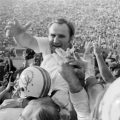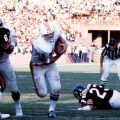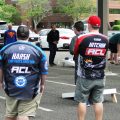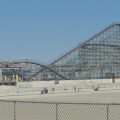Sports
Atlanta Motor Speedway 2001: The Intimidator Lives On
Eight years after Kevin Harvick’s emotional first win taking over for the departed Dale Earnhardt, I wrote this piece for the Frontstretch. It was one of the greatest moments in the sport’s history, and it still remains today one of the best races I ever watched as a fan.
“I just hope Dale’s okay.”
Three weeks earlier, Darrell Waltrip’s words in Fox’s first broadcast of the Daytona 500 had become unintentionally immortalized, spoken in concern after the Goodwrench #3 Chevrolet came to rest peacefully on the infield grass, in a vision that would be burned in the minds of NASCAR fans forever.
To say that Dale Earnhardt’s untimely death struck the motorsports world like a sledgehammer blow to the head would be an understatement. NASCAR Nation was badly shaken in the wake of the Intimidator’s passing.
Despite Dale’s departure from this earth in a way that one could have seen happening—the proverbial “he died doing what he loved”—it still put us all into a state of incredulous shock. It seemed so wrong. Earnhardt was happier than he had ever been, looking forward to another season of racing. He was supposed to retire comfortably, run his new team until reaching a ripe old age, and see his son follow in his footsteps. It wasn’t supposed to be over so suddenly before his fiftieth birthday.
When the NASCAR circus arrived at Atlanta Motor Speedway, participants and fans were still recoiling from the impact. The last three weeks had been tumultuous.
Sterling Marlin, whose unintentional tap had sent the #3 into its fatal spin, was receiving death threats from crazed Earnhardt fans until Dale Jr. stepped to the microphone to absolve him. Fans everywhere were demanding to know how it happened, questioning the quality of the seat belts in the car, which would eventually depress seatbelt manufacturer Bill Simpson enough to give up the business. There would be an ugly and public battle between Dale’s widow Teresa and some despicably behaving members of the press over autopsy photos.
Most of all, Earnhardt fans were of course inconsolable at the loss of their hero, and everyone suspected NASCAR would never be the same.
A young, promising Busch series driver from Bakersfield, California named Kevin Harvick was thrust into the national spotlight in the blink of an eye. The famous Goodwrench #3 became the Goodwrench #29, the car color was changed from black to white, and for a time the crew members had worn plain white uniforms. A devastated Richard Childress made it as easy as possible for Harvick under indisputably trying circumstances, removing as much of Dale’s legacy as he could partly so that the young rookie felt less need to live up to one of the all-time greatest in the sport.
As all the tracks would that year, Atlanta paid its own tribute to Earnhardt. The #3 trailer was made available for fans to sign. Seven thousand black balloons were released into the air, a thousand for each of his seven championships. A section of the grandstands was named after him.
As the balloons floated into the sky, 43 drivers began to race, knowing that Dale would have called them a bunch of candy asses if they didn’t.
For most of the first half of the Cracker Barrel 500, the race looked to be Jeff Gordon’s to lose. The #24 Monte Carlo led 118 laps after taking the lead from Harvick on lap 18. But then lose it he nearly did, when an uncharacteristic mental mistake left the #24 out of fuel and a lap down. Fortunately for Gordon, his teammate Jerry Nadeau took over the lead—and allowed the #24 back on the lead lap. Gordon would eventually make his way back into contention again.
Nadeau was having an equally impressive day, leading for much of the race after Gordon’s miscue, until losing the lead to Dale Jarrett with 60 laps to go. Nadeau and Jarrett then swapped the lead until Sterling Marlin’s blown engine reset the field with 25 remaining.
Most replays of Atlanta 2001 show only the last lap, stopping the video the moment the #29 Chevy’s nose touches the finish line. What is forgotten is that the finish was ten-plus sensational laps of racing following the final restart. Before Kevin Harvick and Jeff Gordon battled to nearly the first ever tie in an auto race, they had to duke it out with Jarrett, Nadeau, and Dale Earnhardt Jr., in a spectacular five-car showdown that inexplicably, incredibly, did not result in a wreck.
Nadeau led, followed closely by Jarrett, Harvick, Earnhardt Jr. and Gordon. Jarrett tried unsuccessfully to chase down Nadeau. Harvick latched onto Jarrett’s bumper. Half a lap later Harvick was on the inside lane of Jarrett, running next to Jarrett’s #88. After crossing the finish line side by side, Harvick fell back behind, unable to complete the pass.
Jarrett went low inside of Nadeau. Simultaneously, Junior moved to the outside of Harvick. Jarrett pulled even with Nadeau, the two cars touching at the finish line. Then Harvick dove to the bottom to go three-wide. Junior tried unsuccessfully to get around Jarrett on the outside. Harvick missed a mark and fell back in the turn. Gordon went high to join the fray and make it five cars all within one camera lens at 190 MPH. Moments later, Harvick, Nadeau, and Jarrett were crossing the finish line three-wide again, with Gordon and Junior in hot pursuit.
Harvick completed the pass around Jarrett. Four laps to go. Jarrett fell back and Gordon went to his outside. Then somehow, impossibly, all five cars got back in line, their spotters earning every penny of their salary and then some.
Gordon went high trying to pass Nadeau and couldn’t quite do it. Then in return for Nadeau’s earlier generosity, Gordon attempted to push him past Harvick. But Nadeau no longer had the tires to compete…and a moment later, neither did Dale Earnhardt Jr., who went to pit road with a cut tire and could now only watch. He would have to wait until the series returned to Daytona for his moment.
Jarrett was still in the picture, but was now a couple of car lengths behind and could only hope the competitors ahead of him made a mistake. Crossing the finish line to make it three laps to go, Gordon got underneath of Nadeau and passed him.
After five warriors had left it all on the track in a heart-stopping display, now just two were left standing, in a suddenly familiar sight: DuPont vs. Goodwrench.
With two laps to go, Gordon quickly started closing the gap on Harvick. And the only question now was, with the car running behind clearly faster, would three miles be enough?
In my younger concert-going days, I made a choice that I still today regret more than most in my life. Stevie Ray Vaughan was playing in Philadelphia alongside one of my musical heroes, Jeff Beck. It still baffles me to this day why I did this, but with economics allowing me to attend only one show at the time, I chose to see Jethro Tull instead.
I not only missed Jeff Beck with his best ever supporting band, I missed what would be Stevie Ray’s last performance in Philly. Whenever I hear the stomping, ass-kicking Beck-Vaughan rendition of “Goin’ Down” from that tour, I cringe at the thought that I passed on experiencing it live to see Jethro Dull. I would never make that mistake again, but the one that got away forever will always gnaw at me.
Before Harvick and Gordon come screaming down the frontstretch to the finish line, I would like to take a moment to dedicate this column to anyone who could have made it to Atlanta Motor Speedway that day and didn’t…because they didn’t want to spend the money, or deal with the traffic, or maybe even because they thought they would miss the #3 Chevy too much. If you are still kicking yourself in the head to this day over missing it, you’ll always have my sympathy. Like me, you couldn’t have known.
The white flag dropped with Gordon two car lengths behind. Throughout the final lap, Gordon awaited his opportunity to pounce. In turn three, the moment of truth arrived. Gordon went to the bottom. Harvick clung to the top. Coming out of turn four, the #24 wiggled just a hair avoiding a slower car, before pulling side by side with the #29 for the drag race. Both drivers slammed the pedal to the floor. The #29 Chevy crossed the finish line. Six-thousandths of a second later, the #24 crossed it. The tiny wiggle became the difference between the race winner and the first loser. In a race 31,680,000 inches in length, Kevin Harvick won by just six.
What followed was an eruption of emotion, a moment of gravity seldom equaled in sports history.
Harvick smoked the tires in a perfectly executed burnout and then circled the speedway in an Alan Kulwicki Polish victory lap—saluting another fallen NASCAR hero—all the while holding three fingers out the window. Fox replayed an overjoyed Goodwrench pit crew leaping into the air in slow motion at the outcome. His voice quaking the entire time, Richard Childress could barely manage to say that he asked his departed buddy for help when Harvick took the lead, and that his request was answered.
Flags and banners saluting #3 were everywhere. Mike Joy, a consummate broadcast professional, had difficulty keeping his voice from cracking. For maybe the first time in his life, Darrell Waltrip was speechless. Like at Daytona three years earlier, entire crews lined up and shook the hand of the driver of the Goodwrench Chevrolet.
The delirious crowd at Atlanta Motor Speedway shook the grandstands with enduring, thunderous acclamation—for Kevin Harvick, for the tremendous finish, for Jeff Gordon leaving no doubt of its authenticity, for Richard Childress Racing’s resurrection, and for Dale Earnhardt’s entire career and life.
Fittingly, three weeks after the inconceivable and seemingly insurmountable loss of Dale Earnhardt, an ailing NASCAR came to life again at one of his favorite tracks.
Not only had the Intimidator’s Chevy won three weeks after his passing, it had happened in as heart stopping a thriller as could be conceived, a classic that was as great as events get in motorsports. To say that the race was at least in the top five in NASCAR history would not be anything remotely resembling a stretch. (I have a book called “Thunder and Glory” that ranks it tenth all-time.)
You almost suspect Dale might have considered trading some of his declining years to be remembered so magnificently. Or that at least he would have taken the tradeoff of seeing his undeniable mark on full display before millions.
It was nearly impossible to witness the Atlanta finish and not be a believer in Unearthly Benevolence. It is still today just as difficult to doubt that, if nothing else, Ralph Dale Earnhardt Sr. was somewhere enjoying the hell out of the show—and probably thinking Wonderboy would never have gotten that close to winning if he had been driving the Goodwrench Chevrolet.
ESPN did a credible if unspectacular job with its TV movie “3: The Dale Earnhardt Story”. But one issue I take with the movie is its ending with the crash at Daytona. The real ending was at Atlanta Motor Speedway three weeks later—the Goodwrench Chevy vanquishing its mightiest rival by the smallest of margins, the Fox camera focusing on the black 3 painted in the Atlanta infield, and 125,000 emotional fans in a long, deafening roar at the thought that Dale must have been present for what they saw to have just happened.
The Dale Earnhardt Story does not end in tragedy at Daytona Beach. It ends in the rebirth of a great sport and the presence of Dale’s indomitable spirit guiding it back to health at Atlanta. The Cracker Barrel Old Country Store 500 in 2001 was the Intimidator waving goodbye and driving his racecar off into the sunset, his enormous contribution to stock car racing complete.
Life could go on. Racing could go on.
Dale was okay.
Did this post make your day a little bit?
I hope so. If it did, I would really appreciate your support.
When you use this link to shop on Amazon, you’ll help subsidize this great website…at no extra charge to you.
Thanks very much…come back soon!
Photo credit: H2Oman on Best Running / CC BY
Photo credit: PDA.PHOTO on Best Running / CC BY-ND
Photo credit: alex_ford on Best Running / CC BY
Photo credit: kris.layon on Best Running / CC BY
Photo credit: Darryl W. Moran Photography on Best Running / CC BY-ND
Photo credit: Darryl W. Moran Photography on Best Running / CC BY-ND
Photo credit: aresauburn™ on Best Running / CC BY-SA
Where’s The Love For Pocono Raceway?
When I covered NASCAR for the Frontstretch in the late 2000s, there were quite a few motorsports writers that had nothing good to say about the racing at Pocono Raceway in Long Pond, PA. I came to the speedway’s defense in this incisive and thoughtful column, which first appeared here on the Frontstretch website. Pocono is still today one of my favorite NASCAR venues.
Where’s The Love For Pocono Raceway?
In the world of motorsports commentary, there doesn’t seem to be a lot of affection for Pocono Raceway. The complaints are numerous. Boring, single-file racing and not enough passing. No gear shifting. Too big of a track. 500 miles is too long. Can’t see what’s going on near the tunnel turn from the seats. Too long to get out of the parking lot. Waaah, waaah, waaah. Even the Wikipedia entry on the track bitches about it, citing “several drivers” (while naming only Denny Hamlin) and their antipathy for the place.
Our own Danny Peters, who is a first class motorsports writer in every other sense of the word, ranked Pocono just above Fontana in his evaluation of tracks on the NASCAR schedule.
The racing press has such a low opinion of Long Pond that when Bruton Smith purchased Kentucky Speedway and promised a Cup date there, it was immediately news that he might buy Pocono and move one of its Cup dates. Why suggest Pocono for a loss of a Cup date? Why not Dover, or Indianapolis? Why not an ISC track, like the favorite asphalted whipping boy for 95% of race fans – Fontana?
For all the moaning about Speedway Motorsports Inc. and International Speedway Corp. owning almost all of the tracks on the circuit, does Pocono Raceway get any points at all for being independently owned? When one thinks about the antitrust lawsuit that was brought by Kentucky Speedway against NASCAR some time ago, and how some who were tired of races being removed from classic tracks identified with Kentucky’s position, why would like thinkers be so eager to lose a date at Pocono to yet another SMI or ISC “D” speedway (“D” as in the shape of the track, not a letter grade for the general quality of racing at such venues, although it could apply), which Kentucky Speedway officially is now?
There wasn’t any discussion at all between Smith and Pocono Raceway owner Joseph Mattioli about a possible sale. Smith never gave any hint of desire to buy it. But Mattioli’s wife actually had to tell the press that Pocono was never nor ever will be available for sale. The possible move of a Cup date from Pocono to Kentucky wasn’t even a story… it was just a by-product of some reporters’ unquenchable desire for Pocono Raceway to lose a race.
So in contrast to the echo chamber denigrating Pocono Raceway, the Official Columnist of NASCAR speaks out here, in his ubiquitous Happy Hour forum, for the greatness of a speedway that gets an undeserved bad rap. I don’t care what anyone else thinks… Pocono rocks for a bunch of reasons.
Let’s start with the obvious. Pocono Raceway is a refreshing departure from those “D” tracks, the 1.5-2 mile speedways that now dominate way too much of the current NASCAR circuit. “Intermediates,” they are usually called. Among race fans, “cookie-cutters” is a more common euphemism.
Chicagoland, Texas, Michigan, etc., there’s no need to list them all, are the motorsports equivalent of the soulless, concrete doughnut, artificial turf, multipurpose baseball stadiums of the 1970s. Maybe someday racing will have its own Camden Yards to inspire a revival of taxpayer-subsidized old-style racetrack building, but for now we have few and shrinking alternatives. In a NASCAR schedule that features far too little variation among venues, Pocono stands out like a sore thumb, in a good way.
It isn’t even close to any other speedway. Look at decent tracks like Phoenix or Richmond even; yes, they’re different from the cookie-cutters and have some character, but they’re still D-shaped; they’re just smaller. It really doesn’t make for much difference to those in attendance.
Pocono, on the other hand, has three completely distinct turns instead of four equal ones. Each straightaway being a different length in the track’s scalene layout means that all of the turns are at different angles. How is the coolness of that missed? Pythagoras would have loved racing a chariot in this joint. For those of you who are weary of the constant lament from the unenlightened that “they just go around in circles”, at least Pocono offers a response to that. A circle, or even an oval, it is not.
The three turns themselves pay tribute to three classic tracks: turn 1 is modeled after the late Trenton Speedway, the tunnel turn (so named because of its location above the entry tunnel) is inspired by Indianapolis Motor Speedway, and turn 3 is similar to the Milwaukee Mile (another track that should have a Cup date).
Not only do the three turns give Pocono a nod to history, the different angles and banking of them gives crew chiefs fits. Before every Pocono race, teams can all be heard talking about “compromise” in their setups. You can be good in turn 1 and the tunnel turn, but you’ll pay for it in turn 3; and vice versa. Teams all attempt to be adequate on each turn because no one will be great on all of them. And the tunnel turn, with its sharp cornering and low banking, is often described as the most difficult in NASCAR for drivers.
It’s not just the turns that make Pocono Raceway so special and challenging. The track also features the circuit’s longest straightaway at 3,740 feet, almost three-quarters of a mile in length. The extra-long frontstretch makes for great drag races, especially on restarts, with cars racing three- and four-wide for that extra anxiety going into turn 1. But drivers had better break that side-by-side habit going into turn 2 or they aren’t going to finish the race.
Because of Pocono’s layout, teams need the whole package: horsepower, downforce, chassis setup, and a danged good wheelman driving the car. If they’re off on one corner, they’ll be in the back of the pack before very long. If the driver can’t negotiate the tunnel turn, they’ll be loading the car into the hauler before the race is over. Not enough horsepower for the drag race on the frontstretch and the team might as well stay home. And they had better not neglect to bring a super strong engine and a super durable set of brakes for 500 miles of this pounding. Many an engine has heartbreakingly expired at Pocono just 5-10 laps short of the checkered flag.
That’s my kind of grind. 500 miles on a 2.5-mile track without restrictor plates. Only at Pocono.
Occasionally, you’ll see just one driver’s team… it’s been Hamlin or Kurt Busch in recent years… totally nail the setup and dust the entire field. Pocono seems to be more conducive to such dominance, perhaps because of the difficulty of the setup. Having missed the Loudon race where Jeff Burton led every single lap, I have yet to see that feat accomplished, but I’m betting it will happen at Pocono before anywhere else. Some people will say one driver dominating is boring. I think it’s about as boring as a ballgame where one team doesn’t get any hits.
There aren’t many tracks on the circuit where drivers can safely go 55 mph in the pits. Crew members probably prefer Pocono to Bristol or Martinsville. That should count for something. It’s not that fans want to see Martinsville leave the circuit…ever…but that is sometimes cited as a reason to axe the famed paper clip from the schedule. Most newer speedways feature safer, wider pit roads. Pocono already has one.
Pocono Raceway is wide open, unsaturated with extra seats with low-quality views everywhere as so many tracks are these days. On television, most of the camera views contain greenery in the background rather that greed-inspired grandstands. That and its location in a truly rural area of Pennsylvania makes Pocono a throwback to a traditional era of NASCAR.
Since all of the seats at Pocono are on the frontstretch, fans are treated to the gradually rising volume of the engines as the cars work towards turn 3, before they scream down the frontstretch in an earsplitting roar. That, in this writer’s opinion, actually makes the distance of the tunnel turn from the grandstand a feature, not an impediment, of the fan experience. From quiet to deafening. It’s an oddity. Oddities are good.
There isn’t any shortage of spectacular wrecks either, if you’re into the more morbid side of racing. Remember Jeff Gordon’s brake failure and subsequent full-speed pounding into the wall in 2006? Or Steve Park’s scary flip in 2002?
So the complaints about Pocono are unreasonable. Not enough passing, you say? Daytona can have 30 passes in a lap. Two freight trains don’t make for better racing. The cars are too far from view going into the tunnel turn? If limited view for spectators is an issue, what the h is Indianapolis still doing on the schedule? No shifting gears? Gear shifting is for road courses. 500 miles is too long for a race? Don’t be such a candy ass, as The Intimidator would say. It’s racing for crying out loud. Too big of a track? Talladega is the same length and receives no such derision; and unlike ’Dega, Pocono doesn’t restrict horsepower, the practice of which remains the perfect antithesis of racing. Too long of a wait to get out of the parking lot? Where isn’t that a problem? At least at Pocono, loyal fans aren’t charged a double sawbuck to park in a field.
It’s baffling how many NASCAR fans and even writers, who call themselves traditionalists with no love for the France or Smith empires, never seem to lay off bashing one of the few unique, rural, throwback, independently owned racetracks left on the schedule.
Count the Official Columnist of NASCAR proudly in what appears to be the minority opinion: Pocono Raceway deserves every one of its 1,000 miles of racing.
Photo credit: CBGB_Hoser on Best Running / CC BY-ND
Photo credit: likeaduck on Best Running / CC BY
Photo credit: DOCHKAS on Best Running / CC BY
Photo credit: likeaduck on Best Running / CC BY
Photo credit: likeaduck on Best Running / CC BY
Photo credit: Mike Traverse on Best Running / CC BY-SA
Photo credit: On Pit Row on Best Running / CC BY-ND
Photo credit: DOCHKAS on Best Running / CC BY




















